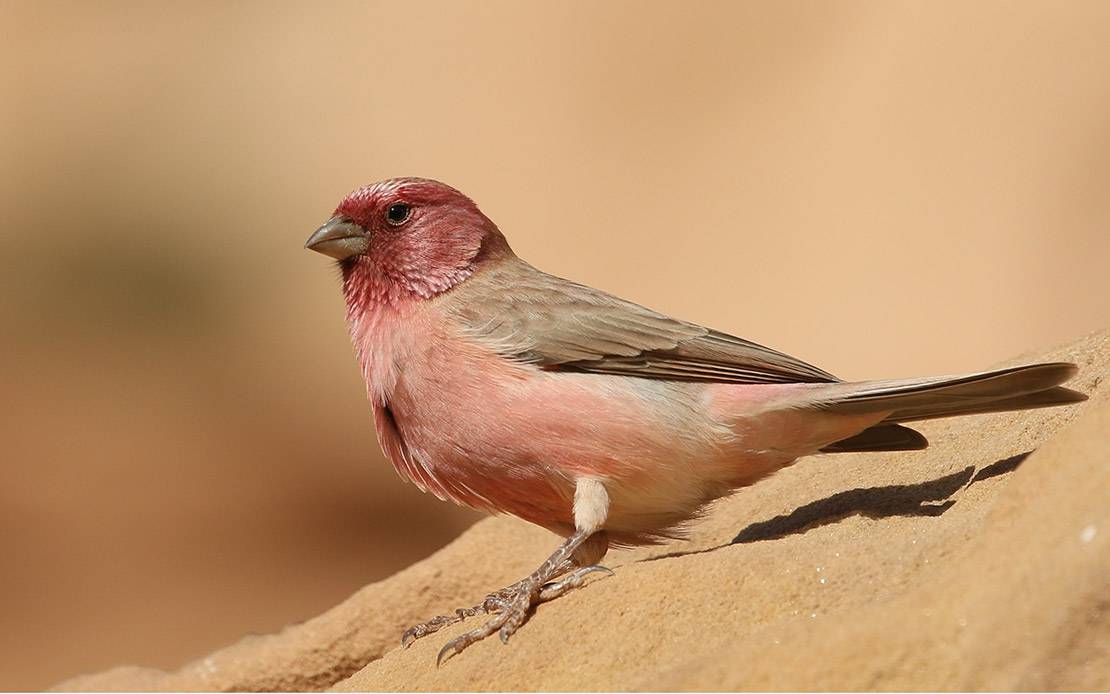Afghanistan – Armenia – Azerbaijan – Bahrain – Cyprus – Egypt – Georgia – Iran – Iraq – Israel – Jordan – Kazakhstan – Kuwait – Kyrgyzstan – Lebanon – Oman – Qatar – Saudi Arabia – South West Russia – Syria – Tajikistan – Türkiye – Turkmenistan – United Arab Emirates – Uzbekistan – Yemen

Capital: Amman
Area: 89,342 km2
BirdLife International partner: Royal Society for the Conservation of Nature (RSCN)
Total number of bird species: 438
Globally threatened bird species: 13
Country endemics: 0
Important bird and biodiversity areas: 18 IBAs with a total area of 5,410 km2
Rare birds committee: Jordan Bird Records Committee (JBRC) – Fares Khoury (Secretary), Ian Andrews, Erik Hirschfeld, Richard Porter, Firas Rahahleh
Specialities:
Desert Owl, Thick-billed Lark, Clamorous Reed Warbler, Hooded Wheatear, Long-billed Pipit, Sinai Rosefinch, Syrian Serin
Ornithological interest:
Jordan is located on the borders of different biogeographical regions and sits at the junction of three continents. The country’s topographic, geological and climatic diversity provides habitats for a wide variety of bird communities.
The northern Jordan Valley contains sites with colonies of Blue-cheeked Bee-eaters, kingfishers and Dead Sea Sparrows, whereas the southern rift is more arid and home to birds including sandgrouse, Arabian Green Bee-eater, Arabian Babbler and Arabian Warbler. Several species of lark and wheatear can be found in the central plateau and eastern desert. The once-famous and extensive Azraq Oasis is now a small protected wetland area which was rehabilitated after it dried out four decades ago, and the site is attractive to migrant and wintering birds.
The highlands of South-West Jordan have relict open woodlands where Syrian Serins breed. In addition to their scenic beauty, the arid mountains and rift margins of southern Jordan are of great interest to birdwatchers. Along with several wheatear species, Trumpeter Finch and Sinai Rosefinch, Sooty Falcons breed here in autumn. This is also the best area to observe large numbers of soaring migrants in spring, assisted by the thermals on their journey from Africa to Eurasia. The Levant Sparrowhawk does not breed in this region but over 90% of the world population is estimated to migrate over Jordan in spring! The best observation sites are Aqaba and the southern rift margins.
Jordan is an excellent country to see a number of regional specialties including Long-billed Pipit which is a local breeder along the higher rift margins. Sand Partridge, Desert Owl, Tristram’s Starling, Fan-tailed Raven, Striolated Bunting and Hooded and White-crowned Wheatears breed in the Rum Desert and along the Dead Sea and southern rift margins. Thick-billed Lark is resident in the eastern desert while Red-rumped Wheatear breeds on the arid highland plateaus of Central and South-West Jordan. The dark-morph, annae subspecies of Desert Lark is resident in the basalt desert of north-eastern Jordan along with the rare Basalt Wheatear. Clamorous Reed Warbler and Dead Sea Sparrow breeding distributions are restricted to the Jordan Valley. The Sinai Rosefinch is a typical resident of arid mountains in South-West Jordan and a breeding population of Syrian Serins is present at Dana. Palestine Sunbird is a common resident in western Jordan.
Best times to visit:
Jordan offers birding opportunities during most of the year but the most suitable season in terms of weather and richness of species is spring. Between March and early June, the climate is warm and both migratory and breeding birds can be observed. July to August have the highest temperatures (above 32°C) and birdwatching is only possible in the early morning. From September, day temperatures become more suitable but, except for the remarkable passage of White Storks during August and September, autumn migration is generally less notable than in spring. Winters are mild in most parts of the country with occasional cold spells. However, the low-lying areas of the Rift Valley have a more tropical climate which is pleasant in winter and this season is suitable for observing resident birds and many winter visitors such as Steppe and Eastern Imperial Eagles, Pallid Harrier, Finsch’s Wheatear and Asian Desert and Cyprus Warblers.
Early spring is perhaps the best time of year to visit to see a wide variety of species including a good mix of migrants and breeding birds, while the period between August and October is best for autumn migration. Wintering birds (especially waterbirds) can occur in large congregations at a number of wetland sites and a visit between November and February can be highly productive.
Essential reading:
Svensson L, Mullarney K, Zetterström D, Grant P (2010) Collins Bird Guide, HarperCollins, UK.
Porter R & Aspinall S (2010) Birds of the Middle East, Christopher Helm.
Andrews, I J (1995) The Birds of the Hashemite Kingdom of Jordan, Ian Andrews (privately published).
بورتر، ر.، أسبينال، س.، 2016. طيور الشرق الأوسط. ترجمة عبد الرحمن السرحان وتدقيق لغوي وعلمي: نابغ غزال أسود. اصدار البيردلايف انترناشيونال وجمعية علم الطيور بالشرق الأوسط والقوقاز. عمان، الأردن.
The above two references in Arabic are the Arabic smartphone app version of Birds of the Middle East (Porter & Aspinall) and the Arabic book version of Birds of the Middle East (Porter & Aspinall).
The Jordan Birdwatch Association website also provides useful, up-to-date information: jordanbirdwatch.com
Trip report links:
February-March 1998 – Syria and Jordan
14 April 2000 – Wadi Rum
January 2002 – Jordan and Egypt
April 2014 – Aqaba and Petra
Compiler:
Fares Khoury
